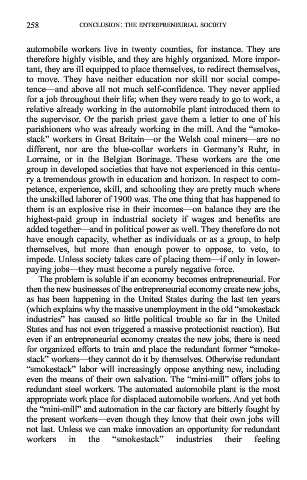Page 265 - ENTREPRENEURSHIP Innovation and entrepreneurship
P. 265
53231_Innovation and Entrepreneurship.qxd 11/8/2002 10:50 AM Page 258
258 CONCLUSION: THE ENTREPRENEURIAL SOCIETY
automobile workers live in twenty counties, for instance. They are
therefore highly visible, and they are highly organized. More impor-
tant, they are ill equipped to place themselves, to redirect themselves,
to move. They have neither education nor skill nor social compe-
tence—and above all not much self-confidence. They never applied
for a job throughout their life; when they were ready to go to work, a
relative already working in the automobile plant introduced them to
the supervisor. Or the parish priest gave them a letter to one of his
parishioners who was already working in the mill. And the “smoke-
stack” workers in Great Britain—or the Welsh coal miners—are no
different, nor are the blue-collar workers in Germany’s Ruhr, in
Lorraine, or in the Belgian Borinage. These workers are the one
group in developed societies that have not experienced in this centu-
ry a tremendous growth in education and horizon. In respect to com-
petence, experience, skill, and schooling they are pretty much where
the unskilled laborer of 1900 was. The one thing that has happened to
them is an explosive rise in their incomes—on balance they are the
highest-paid group in industrial society if wages and benefits are
added together—and in political power as well. They therefore do not
have enough capacity, whether as individuals or as a group, to help
themselves, but more than enough power to oppose, to veto, to
impede. Unless society takes care of placing them—if only in lower-
paying jobs—they must become a purely negative force.
The problem is soluble if an economy becomes entrepreneurial. For
then the new businesses of the entrepreneurial economy create new jobs,
as has been happening in the United States during the last ten years
(which explains why the massive unemployment in the old “smokestack
industries” has caused so little political trouble so far in the United
States and has not even triggered a massive protectionist reaction). But
even if an entrepreneurial economy creates the new jobs, there is need
for organized efforts to train and place the redundant former “smoke-
stack” workers—they cannot do it by themselves. Otherwise redundant
“smokestack” labor will increasingly oppose anything new, including
even the means of their own salvation. The “mini-mill” offers jobs to
redundant steel workers. The automated automobile plant is the most
appropriate work place for displaced automobile workers. And yet both
the “mini-mill” and automation in the car factory are bitterly fought by
the present workers—even though they know that their own jobs will
not last. Unless we can make innovation an opportunity for redundant
workers in the “smokestack” industries their feeling

